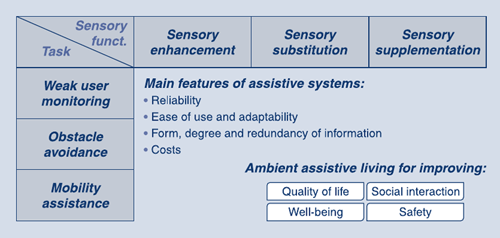Measurement Technologies to Sense Users in the Environment
By Bruno Andò
NOTE: This is an overview of the entire article, which appeared in the December 2012 issue of the IEEE Instrumentation and Measurement Magazine.
Click here to read the entire article.
This article reviews a variety of technological support in Assisted Ambient Living (AAL), that can help a Visually Impaired (VI) person to achieve greater independence of movement in public environments.
Three major types of assistive systems are explored:/p>
- sensory enhancement aims to improve functionality of partially depressed perceptors;
- sensory substitution exploits alternative senses to perceive information not achievable by the depressed function; and
- sensory supplementation uses artificial systems to gain information from the environment.

Classification of aiding systems based on the sensory function they provide.
The article begins with reports on available aids for obstacle avoidance and increased mobility, including descriptions of innovations in this areas that have been developed at the University of Catania, Italy (where the author is an Assistant Professor), including sonar and infrared devices. While aids such as GPS and GIS provide help to individuals walking in an open area, they are of limited usefulness in interior areas; this is where sonar and infrared techniques can be of more help. Also, they can provide feedback on the presence of obstacles.
A new approach to AAL takes a broader view of the situation than simply providing the VI person with enhanced sensory information. Now the emphasis is on recognizing and predicting user needs through a knowledge of the environment and the user’s position and condition, with the help of a ‘Cognitive’ wireless sensor network. This system is seen as particularly of aid to the VI person in case of emergency situations. User posture sensing, position tracking and environmental monitoring are part of this approach. In structured situation, where measurement nodes are positioned in the environment, user position can be accurately determined by triangulation; otherwise, user wearable devices are necessary.
The author describes a wireless sensor network that has been developed using the Zigbee protocol (based on an IEEE 802 standard) using commercial off-the-shelf devices. Various environmental and ultrasound sensors are included in network nodes, while the user wears a module which provides posture estimation and position information. The ‘cognitive’ part of the wireless sensor network performs user localization and is able to recognize the occurrence of emergency situations (e.g., presence of smoke) via environmental sensors.
Extensive references to supporting papers by the author and other researchers are provided in the article.
ABOUT THE AUTHOR
Bruno Andò (bruno.ando@ieee.org) is an associate professor in measurement science at the University of Catania, Italy, where he received his M.S. and Ph.D. in EE in 1994 and 1999, respectively. From 1999-2001, he worked as a researcher with the Department of Electrical and Electronic Measurement (DIEES) of the University of Catania and in 2002, he became an assistant professor. His research interests are MEMS and NANO systems, inkjet-printed sensors, new materials for sensors, smart multi-sensor architectures for environmental monitoring and ambient assisted living and nonlinear techniques for signal processing. Dr. Andò collaborates with several national and international scientific groups and he has co-authored scientific papers presented at international conferences, and he has published in international journals and books.






